

7. Old
Millford

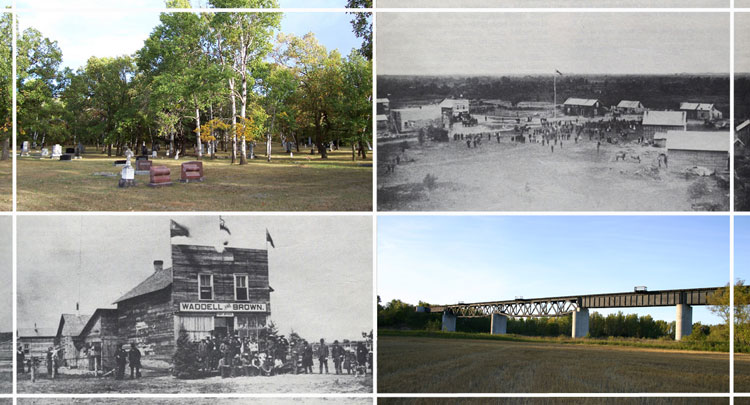
As
a teacher and a
student of
history, I knew a bit about Nellie McClung
and her role in the battle for Women’s suffrage. I had read at
least one
of her works of fiction, and counted myself well informed in general.
But
what I didn’t know, what my high school and university history
courses had
neglected to tell me, was that she grew up just a short distance from
my
home town. I had no idea that in the numerous times that I had
driven down
Highway #2 in the Wawnesa area I passed within sight of the school
yard
were she got her early education, within a few miles of the homestead
where
she grew up. In fact I knew distant relatives of hers, (there still are
quite
a few in the area) before I knew anything about her early life.
My point is that I think I would
have
appreciated
that information. I think
that knowing about a local concrete link to this prominent Canadian
would
have made History a bit more real for me. In fact historians were, and
still
are, somewhat careless about physical details that might establish more
of
a sense of place to the stories of the past. Manioba's definitive
popular historical record, "An Encyclopedia of Manitoba
" (an excellent volume ) lists Nellie’s childhood home,
incorrectly, as Milton.
Where did that come from? I
can't find Milton on my extensive collection Manitoba maps both modern
and historical. And to compound the insult, the older
volume, "Manitoba 125", insists that her family homesteaded
at
Manitou which was where she moved to teach school. [1] In
each case either someone didn’t check even the most
basic of sources, or an editor simply made a mental error. Either way
it
reflects a general lack of concern, a mindset in which such details are
of
little consequence. After all her life's work, the scene of her
triumphs, was far away. My friends in Wawanesa, where Nellie Mooney
married Wesley McClung in a Church that still stands overlooking the
Souris River valley, are not amused by these geographical oversights.
How could anyone not know? The lady who became known as "Our
Nell", was "Their Nell" long before she became famous. Her own memoir,
"Clearing in the West" makes it quite clear where her parents
homesteaded and is full of detail about the community where she grew up
and went to school. Ignoring those roots , or worse still, making them
up, is a denial of the whole importance of roots. And as Charlotte
Gray's biography of Nellie points out, roots are important. It is
important that Nellie moved to a pioneer farming community as a small
child. It is importnat that her parents, each in his and her own way,
were the sort of people who would make such a decision and be
successful in their endeavours. It is important that Nellie met a young
teacher named Frank Schultz, who encouraged her to question and to
think.
Place and circumstance matter if we are to understand acheivement. (And
how can circumstance not relate to place?). They also matter in
terms
of stimulating an interest in history. Thats why I
believe that such details about place are of
consequence.
I think that instead
of bemoaning the fact that interest in history seems to be declining,
we
should be examining the possibility that if we allow for an easier
connection
between the somewhat abstract facts, figures and dates, and the
physical
concrete places, buildings and artifacts, we will find that people
indeed
do like history.
I learned about the local connection to
the
Nellie
McClung story while researching,
of all things, canoe routes. In trying to learn more about the country
I
was passing though, I discovered that there were many forgotten town
sites
along the rivers and that their names were unfamiliar to me. Millford
was
one of them.
Location, Location, Location....
Provincial Road
340 used to run south from Shilo, across the Assiniboine
at the Treesbank Ferry, across the Souris over a beautiful old bridge
just
southeast of the village of Treesbank, and turn east towards
Stockton.
The road remains, although most traffic now flows across the new bridge
just
west of the ferry site, and on into Wawanesa. The ferry ceased to
operate
in the 1980’s, and there is much less traffic on the road between
Treesbank
and Stockton now. Should you happen to take that route, however,
you
will find that just after the road crosses the Souris and turns east,
it
dips through the small steep valley of Oak Creek. As you climb
back
up the other side you should see, on your right, a cairn in a small
open
field, and a cemetery fronted by a row of mature evergreens.
As you walk through the cemetery, you will be
surprised that it is a little
larger than you had expected, and that it extends in a somewhat
haphazard
fashion back into the surrounding woods. The oldest grave there,
however,
can no longer be found today. It is that of a two year-old boy
who
died on May 3 in 1881. It was the first death in the boomtown of
Millford.
[2]
People in pioneer times must have been
more at
home with death than we are
now. It was a more regular visitor. This grave, and others that
surround
it, tell that story well. For Mr. Thomas Hall, who suffered the
loss
of a son, the fact that such deaths were common must have been no
consolation.
He had arrived in the community with the first wave of settlers in the
summer
of 1880. [3] Did he question his decision to move to this remote
territory,
and to locate in a fledgling community far from doctors and
hospitals?
We know that in moments of crisis, some did wonder if they hadn’t
made a
dreadful mistake.
Earlier that same year Letitia Mooney,
from
this
same community, as her child Lizzie lay near death with pneumonia,
cursed
the surroundings and rued the day they had left the relative security
and
comfort of their Ontario home. She had tried the usual remedies;
turpentine,
goose oil, mustard foot baths, and with the closest doctor eighty miles
away
at Portage, it seemed as though all hope was lost. Then a man
arrived
at her door having walked several miles on snowshoes, and introduced
himself
as the newly arrived Methodist Minister. He had with him some
medication
that he thought might help. He stayed three days and the child
recovered.
The minister’s name was Thomas Hall. [4]
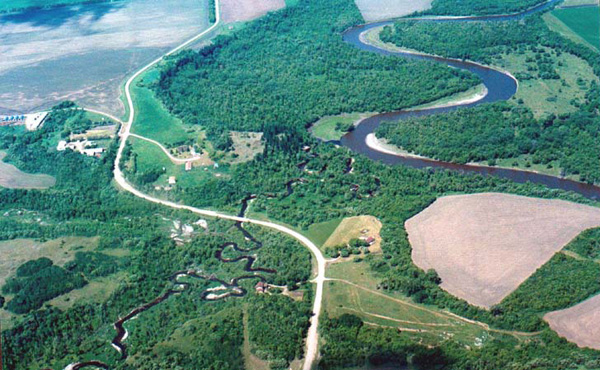
The
Millford Site - 2001
The town was the brainchild of a
Major R.Z.
Rogers from Grafton, Ontario.
He happened to have a brother-in-law, Mr. E.C. Caddy who was to lead a
team
of Dominion Surveyors to southwestern Manitoba in 1879. He asked
him
to keep an eye out for a site for a sawmill and grist mill. His
dream
was to start a new community and to profit from the next wave of
expansion
to the west. [5]
As Mr. Caddy,
along with a
Mr. D.L.S. Huston, were supervising work in the
area near the confluence of Oak Creek with the Souris River, he was
sure
he’d found the ideal spot. After Oak Creek flows into the Souris
River it,
in turn, shortly rolls into the Assiniboine. Steamboats were
already
passing the mouth of the Souris on a regular basis, and it was a short
haul
by smaller craft to the Oak Creek forks. He sent a glowing description
of
an area bordered by three streams. [6] Rogers wasted
no time in assembling men and machinery for the establishment
of his new town. The Winnipeg Daily Times of May 6th, 1880
reported
that seven wagons and one cart were seen headed out in the direction of
the
Portage road, each of them bearing a sign: “For
Millford”. This procession
was reported to be bearing the machinery for the sawmill soon to be
constructed
at the new town site. A Mr. H. Gravely was reported to be
at
the head of the procession with Major Rodgers bringing up the rear with
his
clerk, a Mr. D. Young. The whole tone of the article was one of
optimism
and excitement. [7]
The party did in fact arrive in
the Souris
Valley by the first boat of 1880.
Major Rogers bought land and established his village. At that
time
the area was sparsely populated. William H. Donaldson, who had
come
with the survey in 1879, was living in the area and one of the survey
workers,
Will Mooney, had staked a claim a few miles to the south.
Will had come west from Ontario
after hearing,
from a variety of sources,
that it was a land of opportunity. Thomas White, after visiting
the
prairies in 1878, wrote a series of letters in the Toronto Globe
extolling
the virtues of the new land. A man named Butler had written a
book
called “The Great Lone Land” [8] on a similar theme.
Frank Burnett,
whose name appears in many of the early news reports from Millford was
inspired
to come west after reading Butlers work. [9] And more influential
perhaps,
was the account of a friend, Micheal Lowery, who came back from
Manitoba
with the oft repeated account of wild strawberries so plentiful they
stained
the oxens’ feet as they plowed. [10]

Caddy
surveyed the town
site
into 500
lots featuring a steamboat landing
and a rail line - an optimistic plan to say the least. Note that the
town
is in the “Northwest Territories “ as the Manitoba boundary
wasn’t extended
westward to its current position until 1881.
Taken
from “Historical Atlas of Manitoba.
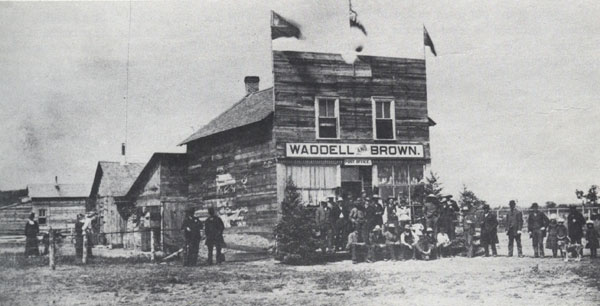
One
of three stores that were established in a short period.
(Manitoba
Archives)

Pioneers
In the winter
of 1879 Will started preparations to welcome the rest of his
family to this paradise. His parents and siblings joined him in
the
fall of 1880. His six year-old sister Helen, whom we now know as
Nellie
McLung, recalls her journey to Millford in her excellent memoir
“Clearing
in the West”. They crossed the Assiniboine a short ways above the
Souris
Mouth and her recollection captures the site perfectly: “The
Souris was a
pretty little stream with deep pools connected by an amber current that
twisted
around the sand bars.” 11]
By July of 1880 the Times
was able to report
that Millford was the “nucleus
of a rapidly extending settlement.” and that it was, “ a
striking example
of rapid, vigorous growth.” The sawmill was up and running, a
store housed
in what was referred to as a “somewhat stylish frame
building” was open and
well stocked, ferries were established and roads begun. [12]Thanks
to Nellie
we do have a very personal
look at the community and the
times, but the importance of Millford as one of the few pre-railroad
settlement
in western Manitoba has ensured that we have several other sources to
help
us reconstruct its short but vibrant existence. When the rails pushed
through
by way of Brandon in 1881 the real rush of settlers followed, but it
took
a special breed of pioneer to strike out before that time. Only a few
actual
communities existed, and most of those were to the north. Rapid City
was
by far the largest village. Grand Valley was really just a post office.
It seems a location destined
to become
“someplace”. It was at the confluence
of the two major rivers of the region. It was on pathways both ancient
and
modern. Native trails and then the path of the Metis buffalo
hunters
passed right by.
So maybe it was more than
just the promotional
efforts of Major Rodgers or
the enthusiasm of Will Mooney that drew people here. But they did come.
And
they created quite a little town, which at first drew substantial
benefit
from its location. It was a jumping off point for settlers both to the
immediate
area and to the centres springing up to the south and west at Cherry
Creek
(Boissevain) Sourisford (Melita) and Plum Creek (Souris). It was the
near
last Mair’s Landing, the last riverboat stop on the Assiniboine
before it
turned north towards Currie’s Landing and Fort Ellice. The
Mair brothers
who came in 1879 and got their start by cutting wood for the big
established
a dock and warehouse where settlers from farther west came to pick up
freight.
It is one of the very earliest named places in South Cypress. [13]
The
town site
itself offered a convenient spot for fording the Souris, and
that also drew traffic. A ferry was soon established over the
Assiniboine
about a kilometre from Souris Mouth to provide a link with Rapid City
and
the newly created city of Brandon to the north.
The industry of the
inhabitants along with the
advantageous location helped
in making Millford an important distribution centre. In reading
through
local histories and personal reminiscences one often comes across
reports
of settlers visiting the newly-formed town. They might have
arrived
there by steamboat on their way to their homesteads, or met newly
arrived
relatives; or perhaps traveled there for supplies or just for social
calls.
It was a hub of communications for the region. Travel was slow,
often
by foot or “shank’s mare” as the expression went, and
therefore even ten
mile trips could be overnight excursions. Some historians credit
Millford
with having three hotels in its heyday. While
some of these might more
accurately
be called boarding houses and/or stopping houses they were important
services. Percy Criddle, who homesteaded south of
the Assiniboine in 1882, recounts a trip to Millford in his journal
where enjoyed " a
glass of beer at the Hotel at Millford - presently came lunch to
me - excellent soup - beef steak - potatoes, turnips, pickled beets,
pie, tea- twenty-five cents - the cheapest hotel dinner I have yet
partaken
of in Canada - also I believe the best. " {13A} (p63) High praise
indeed.
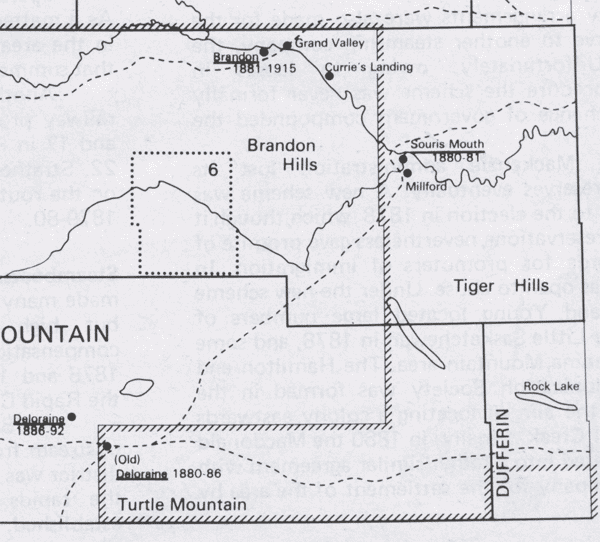 Millford - gateway to Southwestern
Manitoba.
Millford - gateway to Southwestern
Manitoba.
As population
grew other lines of
communications were opened.
One of the first
settlers, Mr. Alex Reid, in a
letter dated May 9th, reported
that he was on board a steamer accompanied by a
considerable
group including Major Rogers, the town’s promoter and Mr. Caddy
who he notes
is a surveyor of considerable experience. He goes on to describe a
sheltered
valley surrounded by Oak Creek and the Souris River with views of both
the
Brandon Hills and the Tiger Hills. In another letter describes Oak
Creek,
“which never runs dry”. [14]
Alex was one of that small first wave of settlers who came on the
steamboats up the Assiniboine, or along the trail through the Spruce
Woods that fur traders had established to reach the Souris Mouth forts
and points beyond. They found ample land available that spring,
but in a letter dated that same fall he tells his grandfather in
Scotland that there was, “not a section of good land within a
radius of fifteen miles of Millford vacant.” Land was
being put under cultivation at a rapid pace. (See
More of Alex's
Letter)
There were
many surprises in store for
them. The winter temperatures
and the summer mosquitoes were two of the more unpleasant ones. Yet
seldom
in the journals and letters do you discern a note of complaint.
As
one reads their accounts of hardship you can imagine the slightly smug
look
of triumph on their faces at the telling. They took the worst
that
nature had to offer and survived. The loss of a few dozen hens to
weasels
might be a setback, but the view of the northern lights (which was
something
new to them) warranted as much comment in Nellie McClung’s
account.

Community
The town grew steadily
at first. While
the sawmill provided the rough
lumber for the first buildings, later buildings would be covered with
shiplap
brought on the steamers or hauled overland from Brandon. For a
while
there were two general stores from which one could get provisions
” at but
a moderate advance upon eastern prices” [15]
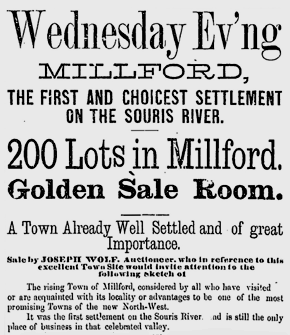 Winnpeg
Times April 23, 1881
Winnpeg
Times April 23, 1881
Manitoba
Free Press March
14, 1882
A report sent to the
Winnipeg Times at the end
of the first season by a Mr.
W.J. Sherwood on behalf of Major Rogers happily reported that:
“There are in the
village a large number
of frame buildings, with stores,
post office, blacksmith shop, and lumber, lath, and shingle
mill.” It goes
on to say that, ”Preparations have been made to have the
Assiniboine steamers
call here next year, the river being navigable from the mouth up to
this
point” [16]
A
blacksmith,
Mr. William Turnbull from Scotland, set up a forge in the town
that first year. His family was living in as tent as where many of the
other
first settlers. His was the third house built, and he acquired it only
by
threatening to leave. The Major could see that a blacksmith was a
necessity
in a would-be agricultural metropolis and obliged by making the
building
of his house a priority. [17]
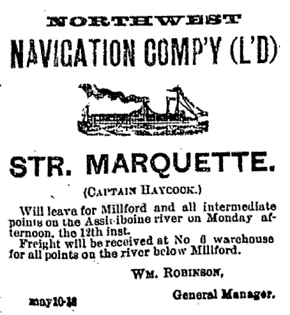
Manitoba
Free Press, May 10, 1884
A warehouse (some refer to it as an elevator)
constructed by Major Rogers
near the junction of the Assiniboine and Souris met a similar
fate.
His plan to capitalize on the location and establish Millford as a
trading
centre for the region was underway quickly. His grist mill was up
and
running, and farmers were hauling their grain to him. Percy
Criddle thought his prices were a bit high compared to Brandon but
appreciated the convenience of dealing locally. [14A] He needed
storage
near the waterway but high water carried it away in 1881. He
rebuilt
and in 1882 again lost it and it’s considerable contents down the
river.
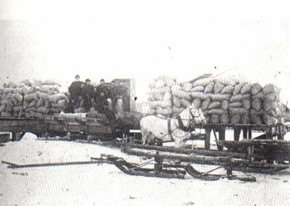 Loads of
wheat at the the
grist
mill in Millford.
Photo
from the Manitoba Archives
Loads of
wheat at the the
grist
mill in Millford.
Photo
from the Manitoba Archives
Alex was one of
that small first wave of settlers who came on the steamboats
up the Assiniboine, or along the trail through the Spruce Woods that
fur
traders had established to reach the Souris Mouth forts and points
beyond.
They found ample land available that spring, but in a letter dated that
same
fall he tells his grandfather in Scotland that there was, “not a
section
of good land within a radius of fifteen miles of Millford
vacant.” [Prev}
Land was being put under cultivation at a rapid pace.
There were many
surprises in store for them. The winter temperatures and the
summer mosquitoes were two of the more unpleasant ones. Yet seldom in
the journals and letters do you discern a note of complaint. As
one reads their accounts of hardship you can imagine the slightly smug
look of triumph on their faces at the telling. They took the
worst that nature had to offer and survived. The loss of a few
dozen hens to weasels might be a setback, but the view of the northern
lights (which was something new to them) warranted as much comment in
Nellie McClung’s account.
The town grew steadily at first. While the sawmill provided the
rough lumber for the first buildings, later buildings would be covered
with shiplap brought on the steamers or hauled overland from
Brandon. For a while there were two general stores from which one
could get provisions ” at but a moderate advance upon eastern
prices” [15]
A report sent
to the Winnipeg Times at the end of the first season by a
Mr. W.J. Sherwood on behalf of Major Rogers happily reported that:
“There
are in the village a large number
of frame buildings, with
stores, post office, blacksmith shop, and lumber, lath, and shingle
mill.” It goes on to say that, ”Preparations have been made
to have the Assiniboine steamers call here next year, the river being
navigable from the mouth up to this point” [16]
A blacksmith, Mr. William Turnbull from Scotland, set up a forge in the
town that first year. His family was living in as tent as where many of
the other first settlers. His was the third house built, and he
acquired it only by threatening to leave. The Major could see
that a blacksmith was a necessity in a would-be agricultural metropolis
and obliged by making the building of his house a priority. [17]
The settlers
were
anxious to surround themselves with the amenities of
life.
They may have been tough enough to survive a fourteen day walk from
Winnipeg
and “cold so intense it split trees wide open” and
they “cracked like
pistol shots”[18], but most of them had come from the relative
“civilization”
of Ontario. They didn’t come here to live the simple rural
life so
much as they came to better themselves. They came to make the
most
of opportunity. As soon as they could they organized themselves
for
the building and maintenance of schools and churches. They
established
Drama and Debating Societies and imported pianos and fashionable
clothes
as soon as time and money would allow. A baseball club was organized.
[19]
Congregations were established, and with time, churches were
erected.
Reverend Hall as we have noted was on the scene from the beginning
advancing
the cause of his Methodist faith. In 1882 Rev. J.S. MacKay, missionary
to
the “Millford and Souris City group of stations”, was able
to report that
“In religious sentiment Presbyterianism largely
dominates” [20]
There were some problems getting clergy, especially when times were
tough.
And article from 1884 points out that “the churches are suffering
sadly from
want of a clergyman both here (Rounthwaite) and in the Millford
district.
The cast iron rule of the Mission Board that unless a specified sum be
contributed
a clergyman cannot be provided, is not adapted to hard times.”
[21] Hard
times didn’t last forever and by 1887 the Sun was reporting on an
“annual”
Easter Monday meeting of the “English Church” at the
school house,
at which funds were being raised. [22]
One
example of
their efforts to establish a sense of community was the
Dominion
Day picnics. The first such picnic was organized in 1880 at the
very
beginning of the town’s short life and features, “baseball,
foot races leaping,
throwing the hammer, putting the stone, sack races, tog of war,
etc.”
[23] One source recalls that on Dominion Day 1881 about 200 people sat
down
to a community dinner after an afternoon of games and festivities.
McLung
remembers the 1882 picnic and credits Frank Burnett a former Montreal
stockbroker
with being the originator of the idea. She recalls boxes of
oranges
and whole bunches of bananas being brought from Rapid City. By
any
account it was a big success and even bigger things
were
planned in 1883,
with a brass band providing entertainment, and horse races and baseball
on
the agenda. The fact that they had to use a ball of yarn as a
ball
and a barrel stave as a bat didn’t dampen their enthusiasm for
this relatively
new sport. [24]
The horse race was something less of a success
however. One young man was
caught using spurs, an argument ensued which escalated into sporadic
brawling.
Apparently alcohol was involved, historians such as Pierre Berton
have suggested
that Nellie McLung’s view on the evils of drink may have been
influenced
as she watched an other wise joyous community gathering marred by the
demon
rum. [25]
Although the unhappy ending to the day’s events may not have been
a factor,
there was no Dominion Day picnic the following year.
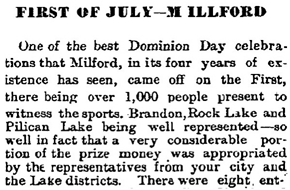
Brandon Sun
July 17, 1884
In 1880 a Land
Office, which
also acted as a post office was established
near Millford, adding to its importance. Pioneers recount going
to
Millford to register claims, but there is some confusion as to the
exact
location. Most accounts refer to the Land Titles Office as being
just
west of the Souris near its mouth, north of where Treesbank is
now.
[26] There was a school at Souris Mouth (also called Two Rivers) for a
short
time as well, but it was located on the other side of the Assiniboine
and
a bit west. By 1882 the railway had reached Brandon, and the Land
Titles
Office was soon moved there, but Millford continued to prosper.
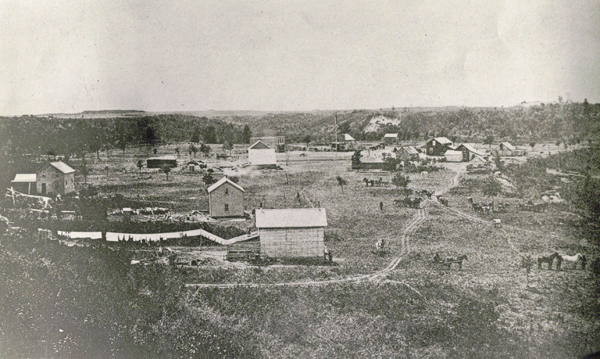 The fact
that several
photos
exist of
Millford in the early 1880's confirms it status as one the the
more important early settlements.
Photo
from "Manitoba Archives"
The fact
that several
photos
exist of
Millford in the early 1880's confirms it status as one the the
more important early settlements.
Photo
from "Manitoba Archives"
Most histories credit Millford as being the
first place to get mail delivery
in the southwestern corner of Manitoba, in effect, with being the first
village
south of the Assiniboine in the Westman area. Mail came via
steamboat
at first, and later over land. Millford appears on a route for
mail
delivery in an 1884 map. [27]
Like
many Manitoba towns, Millford’s rapid expansion had its birth in
speculation
and hopes regarding railway lines. It was part of the
“Manitoba Boom”
that started with Manitoba’s birth as a province and John A
MacDonald’s promise
of a national railway, but reached its apex in 1881 and 1882. In the
late
1870’s this part of Manitoba was the new frontier of a new
country.
The word had spread that the soil and climate would permit the growing
of
grain, and that presence of a rail line would make that grain readily
marketable.
Speculation fueled a rush to buy up parcels of land and promote the
establishment
of towns. Inflated claims went hand in hand with inflated prices
as
ads extolled the seemingly endless virtues of this townsite or that
farmland,
but there were also a few facts to back up some of the claims. In 1882
the
Winnipeg Daily Times reported that:
“The
largest
yield (of wheat crops) is reported at Millford, where 104 bushels
were threshed off two acres.” [28]
So while the Major had
called all the right shots as far as location and
development was concerned, it was apparent by 1882 that to create a
real
centre of commerce, a rail connection was essential. At the time
it
was the only large centre without a railway connection. It had
survived
because of its access to river transport, but in 1883 low water put an
end
to that advantage.
With that in mind
in1882 Rogers went of to Ottawa to secure a branch of the
CPR. He had all the right arguments - it seemed an ideal place
for
a rail line to cross the Souris River on it’s way to settlements
at Plum
Creek (Souris) and points west.

Railways....
When that
didn’t happen other schemes were hatched and avenues
explored.
In fact, in the 1880’s southwestern Manitoba was obsessed with
railways,
and rightly so. Having undergone the hardships of moving to this new
land,
breaking sod and planting crops, they realized that it just
wouldn’t work
without access to markets. You just couldn’t make enough money on
grain if
you had to expend all that energy and time delivering it 50 kilometres
to
the nearest elevator.
No stone was left unturned. At a
meeting held in Pilot Mound on November
of 84 representatives of southern municipalities agreed that with out a
railroad
their hopes for the future were “very bleak indeed” and
that they should
“do their utmost in every legitimate way to secure one” [29]
In 1885 the South Cypress council
authorized a $35 payment to the Secretary
Treasurer of the an entity called the Rock Lake, Souris Valley and
Brandon
Railway [30] to “defray expenses of obtaining a charter”
In August of 1886 Rogers was meeting with
local CPR official to verify that
the Southwestern Railway and the Brandon Sun was announcing that that
line
would be completed only to a point twelve miles east of Millford in
that
year. The railway officials were unable to promise days of
further
expansion and the local farmers reminded them that 50 or 60 thousand
acres
of grain needed to be marketed immediately. [31] By the
time the
branch came to Glenboro in 1886, with no immediate sign of an
extension, many townspeople felt they could wait no longer. The
grist mill had closed in 1885. The
centre with the rail line would be the advantageous place to do
business. People simply packed up and moved, often taking the
buildings with them. The village of Glenboro was virtually
started with buildings moved from Millford. An interesting note in a
Brandon Sun from 1887 under the heading “Millford
Gleanings” tells the tale:
“It is with sorrow that we learn of the death of Mr. McLean of
Glenboro, a former merchant of this place…”
[32]
A few years later this notice appears under the heading “Millford
and Two Rivers”:
“Messrs. Jackson and Gibson have sold out their store in
Millford. Mr. Jackson has taken up residence in
Glenboro…” [33]
When the railway line from Glenboro was extended in 1890 it bridged the
valley on what was then the longest wooden trestle bridge in Canada,
taking it high above the near-abandonned little village.
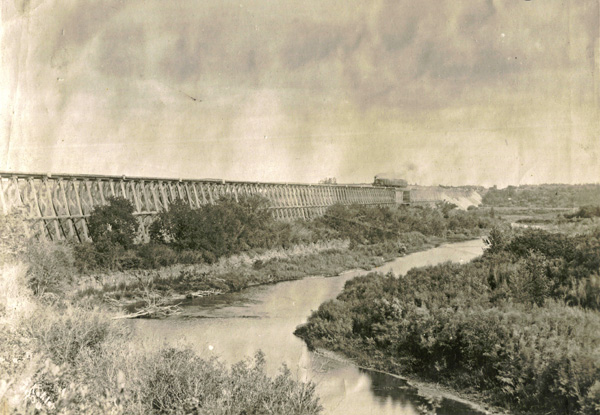
The
Millford Rail Bridge in the 1890's
(Manitoba
Archives)
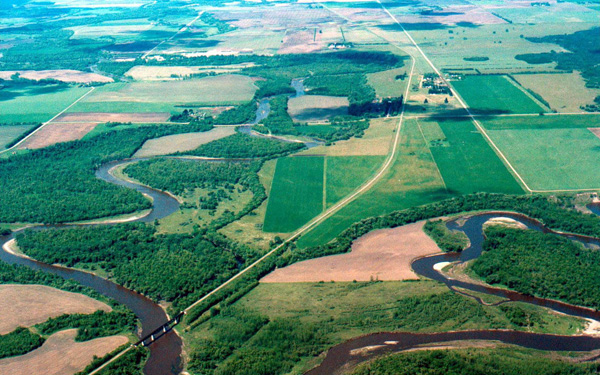
The railway line crossed the Souris just a bit to the northeast of
Millford and the new village of Treesbank (top right), was established.
It is
interesting to note that contemporary news reports offered
no banner headlines or even summary reports detailing the demise
of Millford. Aside from these telltale snippets Millford’s
passing was scarcely noted. A cynical person might suppose that the
absence of such stories reflects the relentless boosterism of the
frontier press, which had no room for such stories. More importantly,
one has to be aware that the abandonment of one site in favour of
another wasn’t seen as a negative thing, it was in fact expected.
The reports weren’t about the failure of one prospective town
site they were about the start of another. Another factor was that
towns weren’t necessarily such a big deal in rural areas.
Communities existed without towns, they were centred around rural post
offices, schools, general stores or churches, alone or in any
combination, but often without the other trademark signs of a village.
The Brandon Sun in its early days routinely included reports from such
districts, identifiable communities without the village. In this
fashion Millford continued to exist even after the buildings were gone.
Although the townsite itself all but disappeared, the community
retained it’s identity for some time. The “Millford
Cricket Club”, for example operated until at least 1906, but it
played its home games at Treesbank.
Today just up the valley wall from where the Oak Creek meets the Souris
(SW 3-8-16) there stands a new cairn inscribed with a tribute by the
area's most famous former resident, Nellie McClung.
This
reminder
and the small cemetery are all that remain of the town that once served
as a commercial centre and stopping place for an entire region. Major
Rogers abandoned his dream and moved back to Ontario. The village that
had grown to about 100 people virtually disappeared. The rail crossing
that Rogers had so eagerly sought was finally built in 1891, right were
he said it should be. It was the longest wooden trestle bridge in the
country at that time. It is still there although it was damaged by
floodwaters and rebuilt of iron.. The site is now merely an interesting
stop on a nearly deserted stretch of back road.

Sources
1.
Both volumes cited are excellent and valuable books but I believe the
mistakes reflect a lack of concern over details when those details are
seen has having only "local" interest. Nellie McLung's childhood
is an open book, literally! "Clearing in the West" details her
experiences and provides an excellent look at the local history
of the area around Millford and provides insight into the pioneer
experience in general. The errors cited are found in: The
Encyclopedia of Manitoba, Great Plains
Publications, Winnipeg MB 2007, 409: Manitoba 125,
Volume Two, Great Plains Publications, Winnipeg MB, 1994, 122. See
also: Charlotte Gray, Nellie McLung, Toronto, Viking Canada, 2008
2. McClung, Nellie, Clearing in the West, Thomas Allen, Toronto, 1935,
95,96
3. Winnipeg Daily Times, July 27, 1880
4. McClung, 79,80
5. McClung, 89
6. Glenboro and Area Historical Society, Beneath the Long Grass,
1979,
14
7. Winnipeg Daily Times, May 6, 1880
8. Butler, William Francis (Sir) 1838-1910. The great lone land: A
narrative
of travel and adventure in the north-west of America . London: Sampson
Low,
Marston, Low & Searle, 1872.
9. McLung 104
10 McLung 30-32
11. McClung, 72
12. Winnipeg Daily Times, July 8, 1880
13. Glenboro and Area Historical Society, 175-6
13A. Criddle, Alma, Criddle-De-Diddle-Ensis, 1973, 71
14. Alex Reid, Letters and Journal, Archives of Manitoba,
Microfilm Ref.
MG8 B61
14A. Criddle, Alma,
Criddle-De-Diddle-Ensis,
1973, 58
15. Winnipeg Daily Times, July 8, 1880
16. Winnipeg Daily Times Dec. 9, 1880
17. Glenboro and Area Historical Society, 16
18. These are a few of the more common descriptions found in local
histories
19. The Brandon Sun Weekly, July 27, 1884
20 Winnipeg Daily Sun, Sept. 21, 1882
21. The Brandon Sun Weekly, June 26, 1884
22. The Brandon Sun Weekly, April 28, 1887
23. Winnipeg Daily Times, July 8, 1880
24. Brandon Daily Sun Weekly, July 17, 1884
25. Berton, Pierre, Marching as to War, Canada’s Turbulent Years
1899-1953, Doubleday Canada, 2001, 103
26. A Rome, A.E. Oakland Echoes
27. Ruggles, Richard I, and Warkentin, John, Historical Atlas of
Manitoba, 406 (Post Office Map 1882)
28. Winnipeg Daily Times, Oct. 12 1882
29. The Brandon Sun Weekly, Nov.13, 1884
30. The Brandon Sun Weekly, Feb. 5, 1885
31. The Brandon Sun Weekly, May 8, and 19, 1886
32. The Brandon Sun Weekly, Oct 20, 1887
33. The Brandon Sun Weekly, March 21, 1889
|

|
|